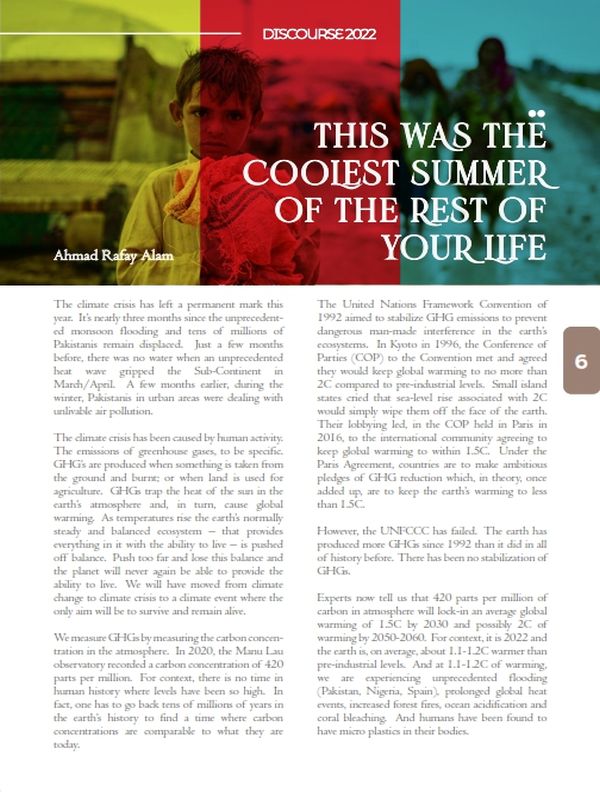This was the coolest summer of the rest of your life
The climate crisis has left a permanent mark this year. It’s nearly three months since the unprecedented monsoon flooding and tens of millions of Pakistanis remain displaced. Just a few months before, there was no water when an unprecedented heat wave gripped the Sub-Continent in March/April. A few months earlier, during the winter, Pakistanis in urban areas were dealing with unlivable air pollution.
The climate crisis has been caused by human activity. The emissions of greenhouse gases, to be specific. GHG’s are produced when something is taken from the ground and burnt; or when land is used for agriculture. GHGs trap the heat of the sun in the earth’s atmosphere and, in turn, cause global warming. As temperatures rise the earth’s normally steady and balanced ecosystem – that provides everything in it with the ability to live – is pushed off balance. Push too far and lose this balance and the planet will never again be able to provide the ability to live. We will have moved from climate change to climate crisis to a climate event where the only aim will be to survive and remain alive.
We measure GHGs by measuring the carbon concentration in the atmosphere. In 2020, the Manu Lau observatory recorded a carbon concentration of 420 parts per million. For context, there is no time in human history where levels have been so high. In fact, one has to go back tens of millions of years in the earth’s history to find a time where carbon concentrations are comparable to what they are today.
The United Nations Framework Convention of 1992 aimed to stabilize GHG emissions to prevent dangerous man-made interference in the earth’s ecosystems. In Kyoto in 1996, the Conference of Parties (COP) to the Convention met and agreed they would keep global warming to no more than 2C compared to pre-industrial levels. Small island states cried that sea-level rise associated with 2C would simply wipe them off the face of the earth. Their lobbying led, in the COP held in Paris in 2016, to the international community agreeing to keep global warming to within 1.5C. Under the Paris Agreement, countries are to make ambitious pledges of GHG reduction which, in theory, once added up, are to keep the earth’s warming to less than 1.5C.
However, the UNFCCC has failed. The earth has produced more GHGs since 1992 than it did in all of history before. There has been no stabilization of GHGs.
Experts now tell us that 420 parts per million of carbon in atmosphere will lock-in an average global warming of 1.5C by 2030 and possibly 2C of warming by 2050-2060. For context, it is 2022 and the earth is, on average, about 1.1-1.2C warmer than pre-industrial levels. And at 1.1-1.2C of warming, we are experiencing unprecedented flooding (Pakistan, Nigeria, Spain), prolonged global heat events, increased forest fires, ocean acidification and coral bleaching. And humans have been found to have micro plastics in their bodies.
There is no safe amount of global warming. The 1.5C and 2C thresholds of the UN framework are actually the most amount of death and carnage world leaders are able to politically absorb. This should shock us. The difference between 1.5 and 2C of warming has been estimated to be in region of 150m people. That’s 4 times the number of soldiers killed in WWI and WWII put together. And most of this death and carnage will take place in “vulnerable” countries like Pakistan. It has already started.
The World Bank climate assessment of Pakistan mentions it is warming in South Asia faster than in other parts of the world. Pakistan is already estimated to be 2C-2.5C warmer than pre-industrial levels and warming is expected to reach 5C by 2060-2080. At these temperatures, agriculture will become impossible and cities unlivably hot. And with such increased temperature will come increased precipitation. In other words more and more ferocious monsoons. The future will most likely be a mix of 8-9 months of unlivable heat and several weeks of ferocious monsoons and then 3-4 months of unlivable air pollution. Over and above the incalculable toll of life, these climate events will repeatedly crush the country’s economy and infrastructure. We had scarcely got up from the 2010 and 2013 floods and now face as much as a US$ 40 billion reconstruction bill. And there will be more (and more severe) climate events in the future. It is time to recognize we have to change our idea of development, of what we can practically achieve, in this climate future.
The development most commonly witnessed in Pakistan is in real estate. And the cement and construction sectors ride on the back of it. In the past several years, repeated Governments have given subsidies and packages to these sectors. To spurn development.
This notion of development needs to change. Development must include the climate security of all Pakistani. The infrastructure they are built must be resilient and designed to save lives. PIDE is in the perfect place to chart out new climate development paradigm.
_____
The author is a Lawyer and Member of the Pakistan Climate Change Council




